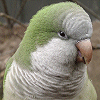Connecticut power company and transformer-nesting monk parrots
Wednesday, May 12 2004 @ 12:08 PM UTC
Contributed by: MikeSchindlinger
CL&P works to accommodate monk parrots
By:Erik Hesselberg 05/04/2004
OLD SAYBROOK - It was a job for the birds - literally.
 A Connecticut Light & Power Company crew did a little maintenance on a pair of large stick nests atop telephone poles on Bridge Street near the causeway, so a colony of monk parrots wouldn't see their home go up in flames.
A Connecticut Light & Power Company crew did a little maintenance on a pair of large stick nests atop telephone poles on Bridge Street near the causeway, so a colony of monk parrots wouldn't see their home go up in flames.
Perched high up in a bucket lift, a CL&P worker gingerly removed twigs from the top of one huge nest, which was up against a transformer and dangerously close to a 13,000-volt line.
"If the twigs hit that line, the nest could go up and we'd have a real problem," said CL&P representative Chris Aiello, who was overseeing the work. "We have a liability problem."
The large, brilliant green birds were clearly anxious about what was going on and could be seen darting in and out of the nest. Several perched nearby on telephone wires screeching and in protest.
The colony of monk parrots started building nests on the Bridge Street telephone poles this winter. The twig and stick structures are now several feet high.
Aiello, who's been monitoring the nests for several months, finally decided they had grown too big. The crew reduced their size and installed animal guards to prevent the birds from making contact with the high-voltage areas. Also, circuit breakers were added on the transformers to prevent the whole street losing power should there be a short.
Aiello said CL&P and United Illuminating have been busy keeping up with the South American parrots, which have been increasingly conspicuous along the Connecticut shoreline, having moved up the coast from New York. These hardy birds, known for their stick and twig nests, have established colonies in Branford and the Milford area.
Jenny Dickson, with the Wildlife Division of the state Department of Environmental Protection, said the exotic birds started showing up in the U.S. in the late 1970s. It is thought the first parrots escaped from a shipment that arrived at New York's La Guardia Airport.
"People wonder how a parrot from South America could survive here, but actually they live in the higher elevations, so this climate is not that different from what they're used to," Dickson said.
Taken from:
http://www.zwire.com/site/news.cfm?newsid=11419521&BRD=1631&PAG=461&dept_id=7931&rfi=6
0 comments
http://www.freeparrots.net/article.php?story=20040512150831506
 A Connecticut Light & Power Company crew did a little maintenance on a pair of large stick nests atop telephone poles on Bridge Street near the causeway, so a colony of monk parrots wouldn't see their home go up in flames.
A Connecticut Light & Power Company crew did a little maintenance on a pair of large stick nests atop telephone poles on Bridge Street near the causeway, so a colony of monk parrots wouldn't see their home go up in flames.